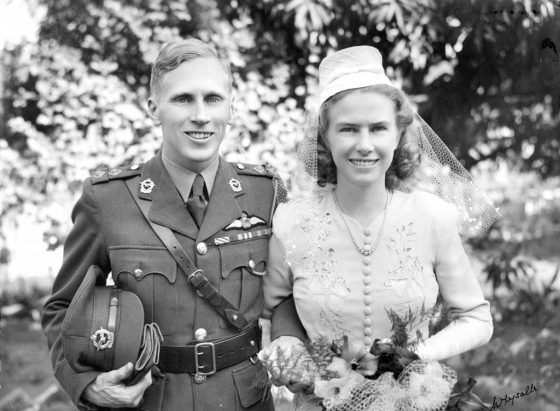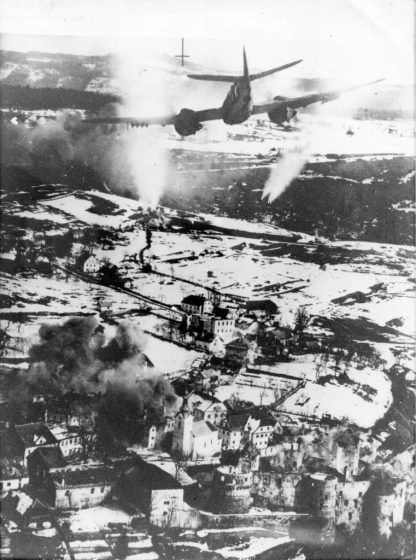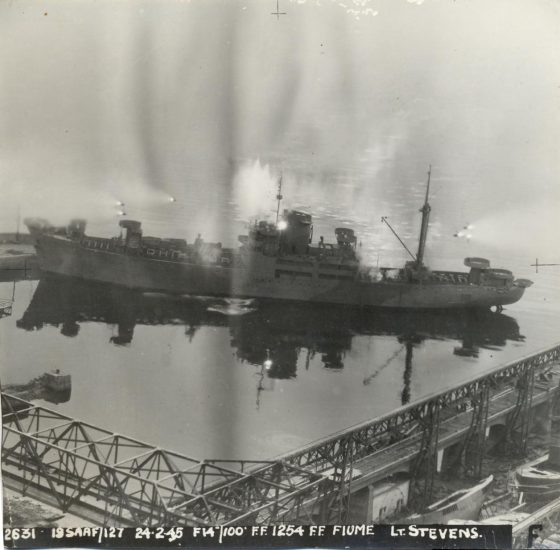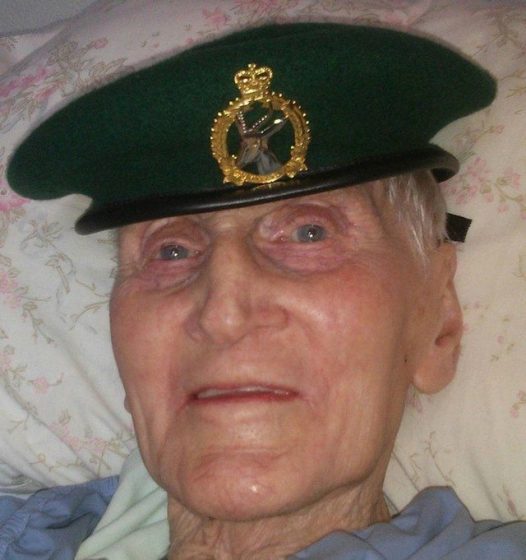

Steve and Kay Stevens
Steve Stevens, DFC, is frail, bedridden and in pain. However, there is no doubt that this man is a force, a man who has packed more into his 96 years on Earth than most of us, and who is firmly committed to his goals and his religion.
When I call him to arrange the meeting, he answers the phone himself. We juggle dates; he has an appointment for a radio interview, and I am keen to come and see him at 10h45 on the 11th November so we could pay our respects to the Fallen together. Eventually we settle on a plan.
Early Life
Steve Stevens was born on 27th August 1919 in Amesbury, Dorset. His father George was gassed in Salonica during WW1 and was sent to a special medical facility in Aberdeen for mustard gas victims, and he met and married Dora, one of the VAD’s.
Steve’s father was not expected to live past 40. However, in typical Stevens fashion George Alexander Stevens took no notice of this pronouncement and his health improved enough for him to take up a new assignment in the Army of Occupation in Germany. The family was billeted in a huge house complete with stables, and young Steve was delighted to be placed in the care of a beautiful young fraulien. Steve adored her, and from her learned to speak German better than he could speak English. Steve’s father had improved in health to the extent that he bought a string of polo ponies and a racehorse called Capitas, which he bought for £9 and rode to victory on local army races.
However, George’s health deteriorated and he was given a year’s sick leave, and the family went to live in Switzerland. There, a 7 year old Steve became proficient in skiing, jumping and skating.
With an improvement in health, the family moved to San Remo in Italy, but Steve’s father was soon recalled to his regiment, and made his way to Ireland and The Troubles. Within a year or so the West Yorkshire Regiment was required in India, but medical advice was that Stevens Senior would not survive the climate, and it was recommended that he was invalided out of the army and moved to somewhere warm and dry.
So it was that the family left for a life on a farm in South Africa in November 1929. George’s health improved, but Steve’s mother Dora suddenly fell ill and died of a brain tumour when Steve was only 14.
When WW2 broke out Steve was at the Bible Institute of South Africa. With the decision to close the college for the duration, some of the students joined the Ministry, and Steve joined the SA Air Force. Steve is convinced that the prayers offered three times a day by his father and stepmother kept him safe during the war. Steve joined the SAAF as a trainee air photographer, but soon re-mustered as aircrew.
The Visit
I arrive at the house, and using the information I have been provided, I left myself in. Steve is on his own in the house, and I make my way to his bedroom.
The blue eyes quickly examine me, and I feel thoroughly vetted and I note a long look at my SA Legion tie and blazer badge. We exchange greetings, and we discuss his interest in photography. Then we pause at 11h00 to commemorate the Fallen.
After some reflection Steve informs me that the radio team that came to interview him was despatched through the house to inventory some books he wanted to donate. They had, under his steely gaze, created a list for my perusal so I could choose which books I wanted to pass on to the SAAF Museum and the SA Legion. However, he then decided that we should take all of the books, and I politely declined as I already had a good number. I was informed that on my next visit more books would be provided.
World War Two

This photograph is widely recognised as the most famous Beaufighter air- strike photo of WWII. It shows my plane attacking the Nazi-held medieval walled town of Zuzenberk. That attack by 8 of our 19 South African Air Force Beaufighter squadron resulted in the Yugoslav Partisans recapturing their town that very day. (Steve Stevens)
During the War Steve flew air strikes over Yugoslavia with 19 Squadron, based at Biferno. These strikes included the daring raid on the occupied walled town of Zuzenberk. The image of Steve firing his rockets is one of the two iconic Beaufighter images of the war. It is astonishing to realise that Steve could accurately hit a target as small as a 44 gallon fuel barrel with his rockets.

Steve photographed Major Tilley attacking the armed German warship SS Kuckuck as Tilley’s number two. It was a desperate sortie which Steve and his fellow pilots fully expected to be a suicide mission. The rockets holed the target under the waterline. The pilots had been briefed by the Partisans that they would face the fire from 140 anti-aircraft guns. Remarkably all four planes returned safely.
60th Anniversary Plaque
Steve and I discuss many topics, and he instructs me to look at a small colourful plaque on a bookshelf. Steve was invited to attend a number of events in Italy, through the efforts of Guiseppe Morini. These events culminated on the 8th May 2005 in Campomarino.
“The ceremonies were in the open air, with a military band, rousing speeches and a fly-past.
Dignitaries from all over Italy were present, while huge flags of all participating countries blew in the wind. The chief of the Italian Air Force, General Leonardo Tricario, was there and a fifty-strong guard of honour marched into the square in our honour. The Italian Air Force also brought in another fifty men – bandsmen who played rousing music.
The warm-hearted Italians responded most generously, and as I put it later to our local newspaper, I’d never been kissed by so many women – and men!”

When we, Second World War airmen who had flown from Termoli in 1944/5 were presented with these VE Day commemoration plaques, I told them I would value this as much as my DFC because it was a plaque of PEACE. A woman hears the drone of a plane and is in fear of being bombed yet again. But as she looks up she sees it is a PLANE OF PEACE. That’s just what I, and my wife Kay, became involved in Africa with our Mission Aviation Fellowship planes.
Until next time.
All too soon it is time to go when Steve’s team get there to take care of him.

I reluctantly leave, but not before I present him with my own beret, which he wears with pride, and when I leave he instructs me to hang the beret on the hat peg next to his SAAF cap.
I leave with a solemn promise we will visit again, and he is looking forward to receiving a membership to the SA Legion UK on our return.
I look forward to meeting him again.
Information with kind permission – Steve Stevens. Article by Cameron Kinnear for the South African Legion – UK & Europe.

